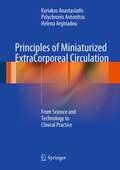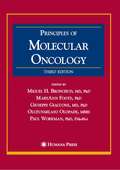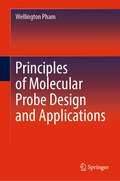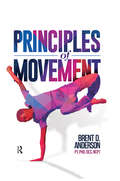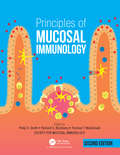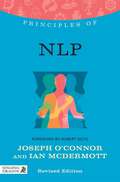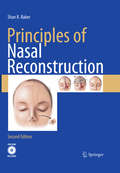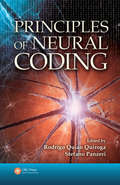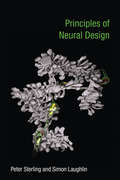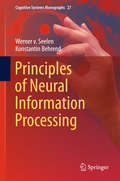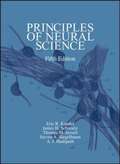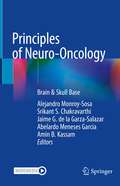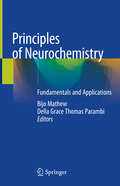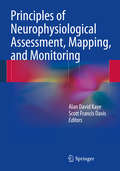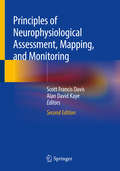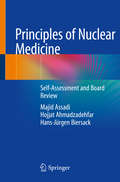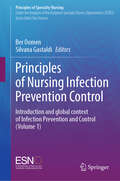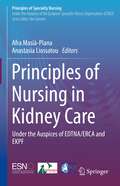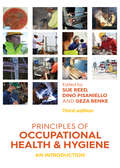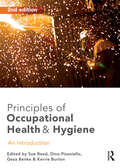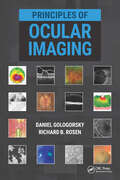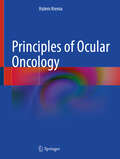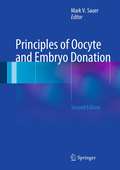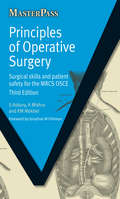- Table View
- List View
Principles of Miniaturized ExtraCorporeal Circulation
by Helena Argiriadou Polychronis Antonitsis Kyriakos AnastasiadisMinimal extracorporeal circulation (MECC) systems have been designed in order to reduce dramatically the side-effects of conventional extracorporeal circulation while serving as a safe perfusion technique for open heart surgery with cardiopulmonary bypass. The book aims to provide an up-to-date and comprehensive overview covering practical advice on how to use MECC systems for those new to the field as well as tips, pitfalls, results, and latest developments. It also offers a systematic review of all published studies on a variety of MECC systems. The book will enable physicians to gain a better understanding of these new systems as well as to understand the rationale for their use in cardiac surgery. MECC requires a multidisciplinary approach, and this book will serve as an essential reference for all health care professionals working in the cardiac surgical operating room, in particular cardiothoracic surgeons, anesthesiologists, and perfusionists
Principles of Molecular Oncology
by Miguel H. Bronchud Maryann Foote K. Antman Giuseppe Giaccone Paul Workman Olufunmilayo I. OlopadeDrawing on years of significant advances and developments, the editors of this third edition have thoroughly updated the highly praised first and second editions and added new chapters to reflect the knowledge emerging from research on genomics, proteomics, chemoprevention strategies, pharmacogenomics, new molecular targets, therapeutic monoclonal antibodies, and innovative cytotoxic and cytostatic small molecular-weight molecules.
Principles of Molecular Probe Design and Applications
by Wellington PhamThis book describes insight mechanisms for designing molecular probes and methods that these agents can be used for medical diagnosis in preclinical animal models via optical, MRI and PET imaging. The book has a wealth of schemes of synthesis and methods deduced from pioneers in the field, making it possible to immerse into real-world molecular imaging. Written for graduate student training and practitioners, this book will serve as a teaching material and/or reference for anyone interested in exploring the power of chemical synthesis of imaging agents.
Principles of Movement
by Brent AndersonFrom the founder of Polestar Pilates, Principles of Movement is a practical resource guide on movement science for movement practitioners, therapists, and anyone looking for a practical and easy approach to assess, facilitate, and enhance movement. With applications in physical therapy, occupational therapy, athletic training, kinesiology, physical education, Pilates training, yoga training, dance education, and more, Principles of Movement is designed to help the movement practitioner improve the quality of their practice by better understanding the integrated model of movement assessment and movement facilitation. The text focuses on how to facilitate the quality of movement—not just the quantity. Author Dr. Brent Anderson draws upon his 30 years of experience in rehabilitation and movement science, showing the strong correlation between motor control and biomechanics, and integrating new work on fascia, pain interpretation, and behavioral elements associated with movement. Principles of Movement is designed to facilitate problem solving and movement enhancement through a deeper understanding of universal movement principles. What’s included in Principles of Movement: • How to harness tools such as breath, mobility, dynamic alignment, control, and coordination to improve movement efficiency and performance, minimize injuries, and increase personal satisfaction through successful movement experiences without pain • Examples, practical applications, and teaching tips for movement practitioners • A guide to critical reasoning that applies the Principles of Movement algorithm to exercise selection and treatment planning • Teaching aids and applications that can be immediately integrated into practice, including verbal, tactile, and imagery cueingPrinciples of Movement provides students and practitioners alike with a framework to evaluate, facilitate, and optimize the quality of movement.
Principles of Mucosal Immunology
by Phillip D. Smith, Richard S. Blumberg and Thomas T. MacdonaldThis respected graduate-level textbook provides comprehensive and accessible coverage of the basic and clinical aspects of the mucosal immune system, addressing the major components of the mucosal barrier ̶ gastrointestinal, upper and lower respiratory, ocular, and genitourinary mucosal immune systems ̶ in a highly user-friendly style. The editors of and contributors to the book, all internationally-recognized leaders, present the current principles, concepts, and basic processes involved in mucosal immunology, mucosal diseases, and host defense at mucosal surfaces. Topics discussed include the development and structure of the mucosal immune system and its cellular constituents, host-microbe relationships, infection, mucosal diseases, and vaccines. The second edition has been carefully updated throughout to reflect the latest developments from clinical research and key literature has been fully updated.
Principles of NLP: What it is, how it works, and what it can do for you Revised Edition
by Joseph O'Connor Ian Mcdermott Robert DiltsNeuro-Linguistic Programming (NLP) teaches how to model excellence to achieve excellence in everything you do. This introductory guide explains the principles of NLP and how to use these principles in your life - personally, spiritually and professionally. By focusing on the fundamental presuppositions of NLP, this clear and concise book gets right to its core. It explains key concepts such as building rapport, modelling, anchoring and uncovering your preferred learning style. It shows how to be in tune with your patterns of behaviour and language and those of the people around you, and how to use this knowledge to reach your goals. From building confidence, to beating depression, to career development, the uses of NLP are innumerable. This book is an ideal starting point for anyone interested in learning the life-changing techniques of NLP.
Principles of Nasal Reconstruction
by Shan R. BakerSkin cancer is among the most commonly occurring cancers, with incidence rates climbing among patients of all ages. The nose is the most common site for these cases. The vast majority of skin cancers of the nose are treated surgically by plastic surgeons, dermatologists, and otolaryngologists. Surgical excision requires reconstruction to one degree or another and Principles of Nasal Reconstruction will prove extremely helpful to any surgeon contemplating reconstruction of defects resulting from skin cancer removal. This book offers multiple guided surgical techniques and references to provide insight and practical guidance to the surgeon and trainee performing nasal reconstructions
Principles of Neural Coding
by Rodrigo Quian Quiroga Stefano PanzeriUnderstanding how populations of neurons encode information is the challenge faced by researchers in the field of neural coding. Focusing on the many mysteries and marvels of the mind has prompted a prominent team of experts in the field to put their heads together and fire up a book on the subject. Simply titled Principles of Neural Coding, this b
Principles of Neural Design (The MIT Press Series)
by Peter Sterling Simon LaughlinTwo distinguished neuroscientists distil general principles from more than a century of scientific study, “reverse engineering” the brain to understand its design.
Principles of Neural Information Processing
by Werner V. Seelen Konstantin BehrendIn this fundamental book the authors devise a framework that describes the working of the brain as a whole. It presents a comprehensive introduction to the principles of Neural Information Processing as well as recent and authoritative research. The books´ guiding principles are the main purpose of neural activity, namely, to organize behavior to ensure survival, as well as the understanding of the evolutionary genesis of the brain. Among the developed principles and strategies belong self-organization of neural systems, flexibility, the active interpretation of the world by means of construction and prediction as well as their embedding into the world, all of which form the framework of the presented description. Since, in brains, their partial self-organization, the lifelong adaptation and their use of various methods of processing incoming information are all interconnected, the authors have chosen not only neurobiology and evolution theory as a basis for the elaboration of such a framework but also systems and signal theory. The most important message of the book and authors is: brains are evolved as a whole and a description of parts although necessary lets one miss the wood for the trees.
Principles of Neural Science, Fifth Edition
by Eric R. Kandel James H. Schwartz Thomas M. Jessell Steven A. Siegelbaum A. J. HudspethUltimately, Principles of Neural Science affirms that all behavior is an expression of neural activity, and that the future of clinical neurology and psychiatry hinges on the progress of neural science. Far exceeding the scope and scholarship of similar texts, this unmatched guide offers a commanding, scientifically rigorous perspective on the molecular mechanisms of neural function and disease―one that you’ll continually rely on to advance your comprehension of brain, mind, and behavior.
Principles of Neuro-Oncology: Brain & Skull Base
by Jaime G. de la Garza-Salazar Alejandro Monroy-Sosa Srikant S. Chakravarthi Abelardo Meneses Garcia Amin B. KassamThis book provides a comprehensive overview of the management of brain and skull base tumors. It features detailed insight into the intrinsic molecular biology, anatomical foundation, radiological planning, surgical execution, and the novel therapeutics that guide today’s treatment regimens. The first section features concepts related to the epidemiology and pathological basis of disease processes, including relevant cellular and molecular biology. In the second section, integral anatomical foundations and principles are covered including microsurgical anatomy of the cerebrum, white matter tracts, ventricles, brainstem, skull base, advancements in radiological imaging, and cognitive examinations. Surgical approaches and how to execute these procedures are then subsequently discussed in the third part of the work. Principles of Neuro-Oncology: Brain & Skull Base is a practically applicable guide to the latest treatment techniques available to treat these patients. Therefore, it is an indispensable resource for all physicians who utilize these methodologies in their day-to-day practice.
Principles of Neurochemistry: Fundamentals and Applications
by Bijo Mathew Della Grace Thomas ParambiThis book provides medical professionals and researchers with a comprehensive overview of fundamental concepts and recent advances in neurochemistry, and offers new perspectives for all those involved with research in related disciplines. As drug discovery for neurodegenerative diseases is one of the largest subspecialties in the field of medicine, the book addresses topics that transcend the borders between disciplines, and presents a wealth of investigations into and discussions on critical questions relevant to the entire field of CNS drug research. It summarizes the available data on the fundamentals of neurotransmitters, treatment of and advanced care for neurodegenerative diseases; and outlines current and future research directions in this field. Combining both conventional and innovative approaches to the topic, the book offers a valuable guide for readers working in medicinal chemistry, the life sciences and allied fields.
Principles of Neurophysiological Assessment, Mapping, and Monitoring
by Alan David Kaye Scott Francis DavisThis book provides foundational knowledge of intraoperative monitoring (IOM) and is written for the range of clinicians who monitor the function of the nervous system during surgery, from new technologists to neurophysiologists and neurosurgeons. Early chapters describe the building blocks of IOM in accessible terms and are followed by practical chapters on monitoring and mapping that show basic and clinical science "in action". Anesthesiologists and trainees with an interest in diagnosing and managing pain will appreciate the inclusion of chapters on the electrophysiological assessment of spinal cord pathology and on the treatment of pain. Principles of Neurophysiological Assessment, Mapping, and Monitoring is designed for use as a text in academic courses or in corporate training programs. It also provides a concise refresher for experienced clinicians and for physicians, neurophysiologists, and technologists preparing for board exams.
Principles of Neurophysiological Assessment, Mapping, and Monitoring
by Alan David Kaye Scott Francis DavisThis book is a comprehensive, focused resource on intraoperative neurophysiological monitoring (IOM). This rapidly evolving field has created a demand for an up-to-date book such as this that builds on foundational concepts necessary to the practice of IOM in the context of anatomy and physiology. Each chapter is designed to not only inform the reader, but to also test the reader on the information presented - therefore promoting practical, problem-based learning. Surpassing the quality of its successful predecessor, Principles of Neurophysiological Assessment, Mapping, and Monitoring, Second Edition, is positioned to suit the needs of residents and fellows studying for the IOM certificate programs, physicians and anesthesiologists practicing IOM, and neurotechnologists both experienced and in training.
Principles of Nuclear Medicine: Self-assessment And Board Review
by Hans-Jürgen Biersack Hojjat Ahmadzadehfar Majid AssadiThis book is the ideal study tool for all who are preparing for national or international nuclear medicine exams and in addition represents a truly outstanding quick review resource. More than 4200 questions, with comprehensive answers, are presented in order to enable readers to assess their knowledge and identify areas of weakness that require further self-study. Informative subchapters permit exploration of specific topics in greater depth, and practice tests will familiarize readers with the process of taking multiple-choice examinations. The book covers the entire spectrum of nuclear medicine, from basic science to clinical applications for diagnosis and treatment. Individual sections focus on oncology, bone and joint disorders, gastrointestinal disorders, acute care, cardiology, neurology and psychiatry, and renal disease. Principles of Nuclear Medicine is highly recommended for those who are taking nuclear medicine or radiology board examinations or recertifying their subspecialty certificate (CAQ) in nuclear medicine. More generally, it will be an asset for all trainees and practitioners of nuclear medicine and radiology.
Principles of Nursing Infection Prevention Control: Introduction and global context of Infection Prevention and Control (Volume 1) (Principles of Specialty Nursing)
by Ber Oomen Silvana GastaldiIn today's rapidly evolving healthcare landscape, the role of nurses in infection prevention and control (IPC) stands as paramount. The first volume embarks on a comprehensive exploration of this critical domain, providing both novice and experienced professionals with interesting insights and strategies. Commencing with a historical journey that traces the evolution of Infection Prevention and Control from Florence Nightingale's pioneering efforts to contemporary situation, encompassing a spectrum from traditional hospital settings to unconventional environments, this volume establishes a robust foundation for comprehending the challenges of IPC. It underscores the pivotal role nurses play in ensuring patient safety through meticulous attention to detail and dedication. It delves deep into the nuances of microbiology, transmission modes, and the paramount importance of adhering to standard and transmission-based precautions.
Principles of Nursing in Kidney Care: Under the Auspices of EDTNA/ERCA and EKPF (Principles of Specialty Nursing)
by Afra Masià-Plana Anastasia LiossatouThis textbook, endorsed by EDTNA/ERCA and ESNO, provides unique evidence-based knowledge about nursing in renal care and harmonises specialised understandings from various countries, to be implemented across numerous national health systems. Renal care nursing is essential in order to promote and prevent renal health as well as detect and contribute to the care of renal disease. These complex tasks require specialised knowledge and training to ensure patient safety and positive outcomes in patient care. This book describes in detail the highest quality practices in different stages of the disease. Twenty-three chapters reflect evidence-based or consensus in practise, covering management and treatment in patient centred care procedures. Combining expert knowledge from many countries, this textbook can be used for teaching new staff in renal care as well as reviewing and updating renal care expertise. Technological developments have significantly expanded in recent years. In this context renal nurses are responsible not only for individualised, comprehensive, and complex patient care, but also advanced technical skills such as haemodialysis treatment, which require close monitoring of patients to ensure safety. Infection prevention and control is vital throughout patient care. In addition, advanced renal nursing skills have been established for the assessment and management of renal disease. The textbook is unique as in one single volume there is evidence, up to date and rigorous data describing different types of renal care therefore it is possible to concept a holistic vision of CKD patients as well as the nursing perspective.
Principles of Occupational Health and Hygiene: An Introduction, Fourth Edition
by Sue ReedNow in its fourth edition, this book allows for early career occupational hygienists and occupational health and safety professionals or students to develop their basic skills and knowledge to anticipate, recognize, evaluate, and control workplace hazards that can result in injury, illness, impairment, or affect the well-being of workers and members of the community. Principles of Occupational Health and Hygiene: An Introduction, Fourth Edition offers a comprehensive overview of occupational health risks and hazardous environments encountered in a range of industries and organizational settings.This new edition offers information on the current techniques and equipment used in assessing workplace hazards. Methods of assessment are developing at a rapid rate due to the new technologies now available. Featuring new chapters on occupational hygiene statistics and psychosocial hazards and fully updated throughout, leading industry professionals and educators explain how to identify key workplace hazards including chemical agents such as dusts, metals and gases; physical agents such as noise, radiation and extremes of heat and cold; and microbiological agents. The book highlights assessment procedures and processes for identifying exposure levels and explains how to evaluate risk and follow safety guidelines to control and manage these hazards effectively. Highly illustrated, up to date with current Workplace Health and Safety legislation and written in a jargon-free manner, this book will be a bible to any student or professional.Principles of Occupational Health and Hygiene: An Introduction, Fourth Edition is an essential reference for students, early career Occupational Hygienists professionals and anyone in an Occupational Health and Safety role.
Principles of Occupational Health and Hygiene: An introduction
by Sue Reed Dino Pisaniello Geza BenkePrinciples of Occupational Health and Hygiene offers a comprehensive overview of occupational health risks and hazardous environments encountered in a range of industries and organisational settings.Leading industry professionals and educators explain how to identify key workplace hazards including chemical agents such as dusts, metals and gases; physical agents such as noise, radiation and extremes of heat and cold; and microbiological agents. They outline assessment procedures and processes for identifying exposure levels. They also explain how to evaluate risk and follow safety guidelines to control and manage these hazards effectively.Chapters are heavily illustrated with detailed case studies, diagrams, flowcharts and photos. Practical guidelines are provided for managing each hazard type. This third edition has been extensively revised and updated and reflects current research evidence and the Workplace Health and Safety legislation on workplace hazards.Principles of Occupational Health and Hygiene is an essential reference for Occupational Hygienists and anyone in an Occupational Health and Safety role.
Principles of Occupational Health and Hygiene: An introduction
by Sue Reed Dino Pisaniello Geza Benke Kerrie BurtonToday's workplaces are full of materials and processes which are potentially hazardous to our health. Industry depends on a large range of naturally occurring and synthetic materials, many of which can adversely affect the health of the workers. Even some non-industrial workplaces can contain hazardous materials or cause exposure to physical or biological agents that can be harmful to health.Principles of Occupational Health and Hygiene offers a systematic and comprehensive overview of occupational health hazards and hazardous environments encountered in a range of industries and organisational settings.Leading industry professionals and educators explain how to identify key workplace hazards including chemical agents such as dusts, metals and gases; physical agents such as noise, radiation and extremes of heat and cold; and microbiological agents. They outline assessment procedures and processes for identifying exposure levels. They also explain how to evaluate risk and follow safety guidelines to control and manage these hazards effectively.Chapters are heavily illustrated with detailed case studies, diagrams, flowcharts and photos. Practical guidelines are provided for managing each hazard type. The second edition has been extensively revised and updated, with new chapters on industrial ventilation, personal protective equipment and emerging issues in the field, and reflects the recent changes in Workplace Health and Safety legislation relating to the hazards discussed.Principles of Occupational Health and Hygiene is an ideal resource for students of Occupational Health and Safety, and a professional reference for Occupational Hygienists, Occupational Health and Safety professionals, and anyone working in an Occupational Health and Safety role.
Principles of Ocular Imaging
by Richard Rosen Daniel GologorskyAn essential text for the modern eye specialist, Principles of Ocular Imaging presents a comprehensive guide of all current ocular imaging modalities for ophthalmologists, optometrists, and those in training. Drs. Gologorsky and Rosen deliver a concise yet thorough overview of 22 imaging modalities unique to ophthalmology, emphasizing clinical application and replete with illustrative examples and ophthalmic images.Principles of Ocular Imaging is divided into the following subspecialties for easy reference in busy clinical environments: Oculoplastics: external photography, ptosis visual fields, slit lamp photography, and orbital ultrasonography Cornea and refractive: corneal topography, confocal microscopy, anterior segment optical coherence tomography (AS-OCT), ultrasound biomicroscopy (UBM), biometry for intraocular lens (IOL) calculations Glaucoma: visual fields, optical coherence tomography (OCT) in glaucoma Retina: fundus photography, fluorescein angiography (FA), indocyanine green (ICG) angiography, fundus autofluorescence (FAF), OCT in retina, optical coherence tomography angiography (OCTA), adaptive optics (AO), microperimetry, retinal ultrasonography Neuro-Ophthalmology: electrophysiology of vision and computed tomography (CT) & magnetic resonance imaging (MRI) A practical, illustrative guide to ophthalmic imaging, Principles of Ocular Imaging is an indispensable addition to the practicing ophthalmologist’s professional library.
Principles of Ocular Oncology
by Hatem KremaThis book is an up-to-date, single-volume, concise reference in ocular oncology. The book is divided into eight chapters. The first chapter is an introduction to oncology in general that covers basic concepts in cell biology, tumorigenesis, the hallmarks of cancer, and tumor pathology. The second chapter discusses the standard treatment methods employed in ocular oncology, including surgical approaches and techniques, treatment with physical energy such as radiotherapy, lasers, and cryotherapy, and the indications and toxicities of systemic and regional drug therapy. The following five chapters demonstrate the examination, classifications, clinical and imaging presentation, and current specific management options of tumors and relevant lesions that involve the eyelid, ocular surface, orbit, uveal tract, and retina. The final chapter highlights the direct and indirect impact of systemic cancers on the ophthalmic tissues and their management. The book has been richly illustrated with over 350 original figures, schematic representations, and comparison tables. Principles of Occular Oncology is a must-have resource for ocular oncology specialists and trainees, general ophthalmologists, and allied cancer care specialists who manage ophthalmic tumors.
Principles of Oocyte and Embryo Donation
by Mark V. SauerThe versatility of oocyte and embryo donation has proven to be extremely valuable to both patients and doctors engaged in reproductive medicine. Originally thought to be applicable only to a rather small subset of infertile women, today busy practices commonly recommend the procedure and it is estimated that nearly all of the 400 or more IVF programs in the United States provide these services. Oocyte and embryo donation has established itself as a mainstay procedure within assisted reproductive care, and the breadth, depth and complexity of practice is deserving of focused attention. Much has changed within the field of oocyte and embryo donation since the publication of the first edition of Principles of Oocyte and Embryo Donation in 1998, thus the need for a completely updated and more expansive text. The second edition of this book provides an overview of the major issues affecting men and women engaged in the practice of oocyte and embryo donation. A primary emphasis has been placed on defining the standards of practice that have evolved over the past 30 years, clearly stating the outcomes expected from adhering to these established protocols. Details of both the basic science and the clinical medicine are presented together and attention is also focused on the non-reproductive aspects inherent to this unique method of assisted reproduction that involves opinions from lawyers, ethicists, mental health care professionals and theologians. Oocyte and embryo donation requires a working knowledge of the medicine, the law and the ethics that underlies its foundation. This book is intended to serve as a complete and comprehensive reference for all health care professionals that provide services related to egg donation, reproductive endocrinologists, obstetrician- gynecologists, and fellows and residents entering the fertility field.
Principles of Operative Surgery: Surgical Skills and Patient Safety for the MRCS OSCE, Third Edition (MasterPass)
by Sarah Asbury A Mishra K M MokbelA comprehensive selection of multiple-choice questions for the 'Part 1' of the Membership of the Royal College of Surgeons (England) examination and its Scottish equivalent the AFRCS. Questions have been chosen to reflect the structure of the examination and include many that are similar to those that were asked over the last few years. Both the Core Module and the System Module of the examination are covered. Detailed answers are provided. Kefah Mokbel has written a number of books for the surgical examinations as well as for other professional examinations and is also the principal lecturer on the MasterPass MRCS course. This book reflects his considerable experience of the MRCS examination and will be invaluable to candidates preparing for this examination.
